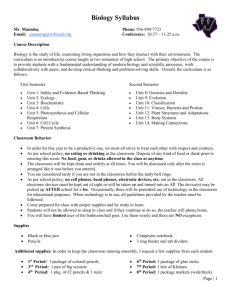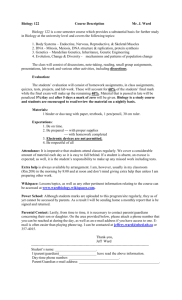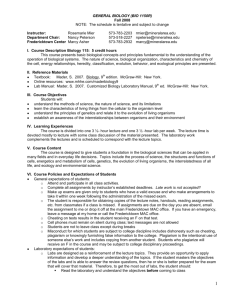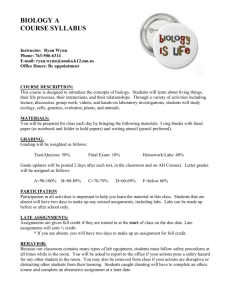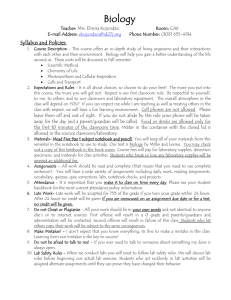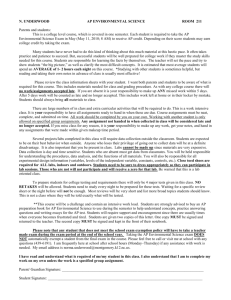biology 11 * course outline
advertisement
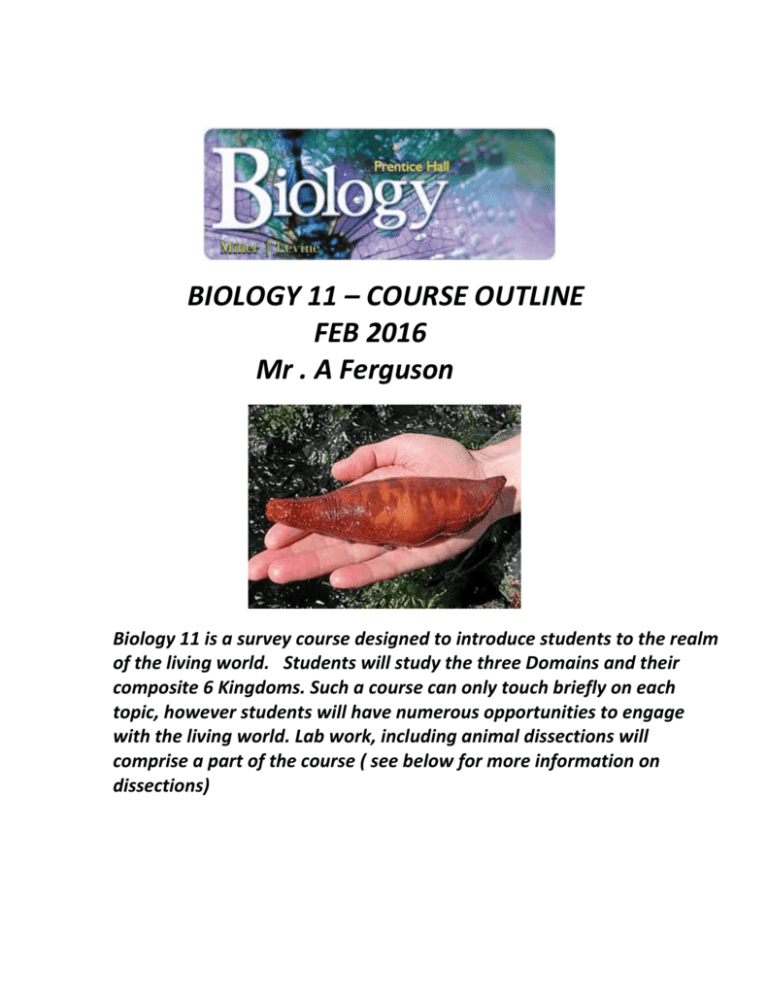
BIOLOGY 11 – COURSE OUTLINE FEB 2016 Mr . A Ferguson Biology 11 is a survey course designed to introduce students to the realm of the living world. Students will study the three Domains and their composite 6 Kingdoms. Such a course can only touch briefly on each topic, however students will have numerous opportunities to engage with the living world. Lab work, including animal dissections will comprise a part of the course ( see below for more information on dissections) COURSE EXPECTATIONS Biology 11 is a senior science course. Students can expect to have homework and assigned reading most nights as well as research papers and formal written lab reports Homework will be checked regularly and incomplete or missing homework will be recorded as an empty mark. Although this will not count against you, nor will it count for you. Instead, it will reduce the number of available marks, making the other tasks worth even more ( see tests and exams below). Since this course is a survey course, no subject is covered in depth, however the broad volume of the course means that there will be significant work. Students should expect to dedicate about one hour per night to this course. NOTES Class lectures should be kept in a separate binder. Each class will normally include lecture notes and follow up homework questions. These should be brought to class each day and be available to be marked upon request. All notes will be posted from the SMARTBOARD to the Biology 11 webpage notes each day. These notes will be in pdf. and/or ppt. format. Students may also opt to download the Notebook© program from http://www.smarttech.com/Support/Browse+Support/Download+Software/Software/SMART+Noteb ook+collaborative+learning+software/SMART+Notebook+software/SMART+Notebook+11_2+Win This will allow students to use the notes as they were generated in the class. It also will facilitate students who wish to use the SMARTBOARD to present reports and assignments. ASSIGNMENTS - Study guides, projects and activities not considered formal labs all are considered as assignments. These will typically have several days to a week to complete. Some will be submitted and others will be presented in a seminar format. Any late assignments will be evaluated separately, depending on the circumstances. LABS Any written labs will be kept in a notebook or duotang. Students will receive an instruction sheet for all formal labs and assignments. All labs will be marked out of 15 following the marking scheme provided. DISSECTIONS – There are 3 scheduled animal dissections; the earthworm, the sea star and the rat. All dissections are OPTIONAL activities provided to enhance student understanding of internal anatomy and physiology. NO student will have to do a dissection. They may choose instead to observe, remain in the room, or else be excused. TESTS There are two in –class tests . Each test will be worth 10% of the course. If a student is absent for a test, they will be expected to write it the day that they return. Any exceptions can only be considered if accompanied by a note of explanation from home. FINAL EXAM – The exam is a cumulative written assessment. It will cover the entire semester equally. The weight of the exams and tests together will make up 50% of the course evaluation. Tests and exams will follow a standard format. All course materials that can be created or converted into digital documents ( including these outlines) will be available through the website at www.stjohnbrebeuf.ca/curriculum/biology11 TOPICS UNIT 1 – ADAPTATION & EVOLUTION Chpt 1, 15, 16, 12 - Characteristics of Life Darwinism Natural Selection and Speciation Population Genetics DNA replication TIMELINE FEB UNIT 2- MICROBIOLOGY Chpt 18, 19, - - Viruses o Viral replication o Lysis and Lysogeny Eubacteria pathogens Classification Domains and kingdoms Évolution of plants and plant diversity MAR UNIT A TEST UNIT 3 – PLANTS Chpt , 22, 24 - - Non- vascular bryophytes Vascular plants o Angiosperms APR o Gymnosperms fruits Plant Ecology UNIT 4 – ANIMALS & ECOLOGY Chpt 26, 27, 28 , 34, 5 - UNIT B TEST Animal Morphology and germ tissue Sponges and Cnidarians Worms o Flatworms o Roundworms o Earthworms MAY o o o o - Arthropods Arachnids Insects Camouflage - Animal Behaviour Population Dynamics JUN FINAL EXAM REVIEW COURSE EVALUATION HOMEWORK ASSIGNMENTS LABS & QUIZZES UNIT TESTS FINAL EXAM 15 % 20 % 20 % 20 % 25 % TOTAL ------------------------------100 %
